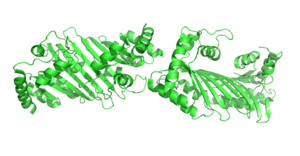APOBEC

| APOBEC-like N-terminal domain | |||||||||
|---|---|---|---|---|---|---|---|---|---|
| Identifiers | |||||||||
| Symbol | APOBEC_N | ||||||||
| Pfam | PF08210 | ||||||||
| InterPro | IPR013158 | ||||||||
| |||||||||
| APOBEC-like C-terminal domain | |||||||||
|---|---|---|---|---|---|---|---|---|---|
| Identifiers | |||||||||
| Symbol | APOBEC_C | ||||||||
| Pfam | PF05240 | ||||||||
| InterPro | IPR007904 | ||||||||
| |||||||||
APOBEC ("apolipoprotein B mRNA editing enzyme, catalytic polypeptide") is a family of evolutionarily conserved cytidine deaminases.
Function
A mechanism of generating protein diversity is mRNA editing. The APOBEC family of proteins perform mRNA modifications by deaminating cytidine bases to uracil. The N-terminal domain of APOBEC-like proteins is the catalytic domain, while the C-terminal domain is a pseudocatalytic domain. More specifically, the catalytic domain is a zinc dependent cytidine deaminase domain and is essential for cytidine deamination. The positively charged zinc ion in the catalytic domain attracts to the partial-negative charge of RNA.
In the case of APOBEC-1, the mRNA transcript of intestinal apolipoprotein B is altered. RNA editing by APOBEC-1 requires homodimerization and this complex interacts with RNA-binding proteins to form the
C-to-U modifications do not always result in the truncation of proteins. For example, in humans/mammals they help protect from viral infections.[5][6] APOBEC family proteins are widely expressed in cells of the human innate immune system.[7]
Cancer
These enzymes, when misregulated, are a major source of mutation in numerous cancer types.[5][6][8] When the expression of APOBEC family proteins is triggered, accidental mutations in somatic cells can lead to the development of oncogenes, cells which have the potential to develop into a tumor. APOBEC proteins are further expressed in attempt to regulate tumor formation. This makes APOBEC proteins a helpful marker for diagnosing malignant tumors.[9]
Structure
A 2013 review discussed the structural and biophysical aspects of APOBEC3 family enzymes.[10] Many of the APOBEC protein features are described in the widely studied APOBEC3G's page.[tone]
Family members
Human genes encoding members of the APOBEC protein family include:
- APOBEC1
- APOBEC2
- APOBEC3A
- APOBEC3B
- APOBEC3C
- APOBEC3E" now refers to this)
- APOBEC3F
- APOBEC3G
- APOBEC3H
- APOBEC4
- Activation-induced (cytidine) deaminase(AID)
References
- .
- PMID 12683974.
- ^ McKusick VA, Hamosh A (19 December 2019) [Originally published 27 September 1994]. "APOLIPOPROTEIN B mRNA-EDITING ENZYME, CATALYTIC POLYPEPTIDE 1; APOBEC1". Online Mendelian Inheritance in Man. Retrieved 23 December 2023.
- PMID 12446660.
- ^ a b "Unexpected DNA-Binding Mechanism Suggests Ways to Block Enzyme Activity in Cancer". Dec 2016.
Based on ("Structural Basis for Targeted DNA Cytosine Deamination and Mutagenesis by APOBEC3A and APOBEC3B") online in Nature Structural and Molecular Biology.
- ^ S2CID 236934922.
- PMID 23431045.
- PMID 36978147.
- PMID 17560277.
- S2CID 4151961.
